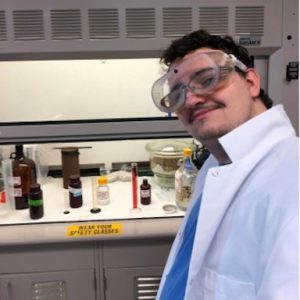The Soil and Water Sciences Department is offering students the chance to blog about their summer experience. The students enrolled in one of three courses over the summer, for which they received credit: SWS 4905-Individual Work, SWS 4911-Supervised Research in Soil and Water Science, and SWS 4941
Practical Work Experience. This is Chance McLeod’s summer internship:

My name is Chance McLeod and I’m studying Environmental Management in Agriculture and Natural Resources. This summer, I worked as an intern with researchers in the UF/IFAS Soil and Water Sciences Department – in the lab on campus and doing fieldwork in Homosassa, Florida.
Scope of Work
In the field, I did piston core collection of sediment samples. I also worked on recognizing signs of seagrass scar and different types of marine vegetation. To help with those tasks, I also completed an online boating education course and learned various aspects of nautical law and communications.
Work completed in the lab included determining total phosphorus by different methods, weighing multiple sediment cores from Sandy Hook and Homosassa (including extracting plant matter), and breaking down plant tissues with a mortar and pestle. I also learned the EPA method of cleaning lab instruments – wash three times and an acid bath. Other lab work consisted of transferring data to Microsoft Excel and then organizing and graphing data using online software. All interns also assisted on a bulk density research poster with graduate student Conor MacDonnell.
My goal for this internship was to learn more about seagrass scarring at Homosassa and Sandy Hook. I have learned there is a successional model present for these systems in that Halodule will grow first, followed by Thalassia. However, seagrass scarring caused by human boating could impact this ecological succession. That, in theory, would affect recovery efforts. Much of my learning occurred in the laboratory space. I had to learn specific procedures on how to measure, organize, classify, and prepare samples for measurement.
Learning Experience
Of the previous courses I have taken, I think SWS 4223-Environmental Biogeochemistry was the most important one related to my internship. I’ve taken other courses involving land management (SWS4116 and ALS3133), which provided useful information, as well as wildlife courses, which helped with ecosystem management.

I learned it is quite challenging at times to perform research on this topic. This is due to the unpredictability of Florida weather. Rain can cause the current to be unsafe to enter the water or it might be too strong to receive soil cores. One field day, Connor found a large crab on the seafloor, which he brought up to show me. I found that to be pretty interesting. Homosassa has a variety of marine species that are all beautiful.
Something interesting I learned in the lab was that you are not supposed to touch the insides of glass containers you will use to measure samples. This is true even if you are wearing gloves. The reason: Latex can rub off on the sides and possibly contaminate measurements.
 0
0
